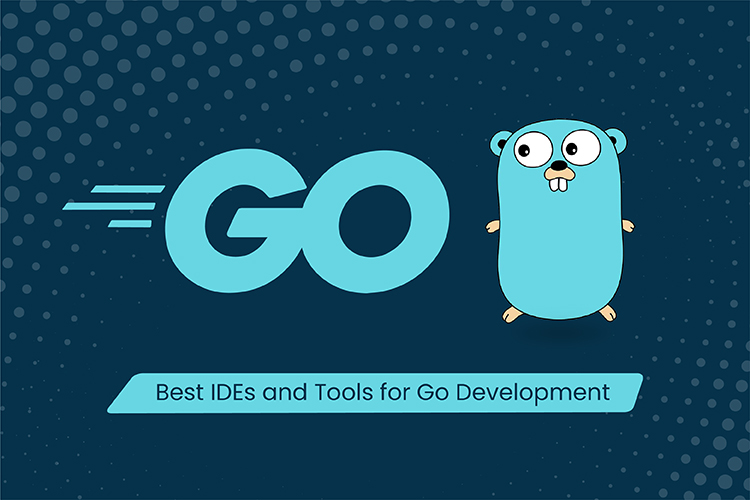Top IDEs and Tools for Golang Development
- Web
- October 10, 2023
Since its introduction in 2007, Golang, Google’s Go Programming Language has been encountering immense popularity among common users. It’s a new language, considering modern architectures, and made to be effective, competitive, and simple.
Generally made for building low-level monoliths for Google, Golang has ultimately proved especially best suited to service-oriented architectures due to its easy deployment, productivity, and scalability. Voluntarily, it’s a minimalist language, which has just 25 keywords that will possibly not evolve. Every new function is included in the standard library, as new functionality and not added to the language itself.
As an open-source, compiled programming language, Golang makes it simple for developers to create dependable, easy, and proficient software. Golang reduces the amount of code typing and writing unique APIs without compromising its performance. Made for concurrency and scalability, the Go helps in optimizations.
Read also: Top Web Frameworks for Development in Golang
In this blog, you will get a list of Golang tools and IDEs for your rapid choice. Explore them whenever you plan for working with Go!
Top Golang IDEs
Golang IDEs are becoming popular these days. In case you are involved in a large-scale project with a broad codebase, IDEs can help you streamline your code and navigate it easily. Moreover, IDEs help examine a code and edit them as per your preference.
Here is the list of the best Golang IDEs to be used for Go development:
1. Visual Studio Code
Microsoft’s Visual Studio Code is an open-source, full-featured code editor and IDE that supports numerous types of programming languages. It boasts a robust completion with IntelliSense, call stacks, in-built Git integration, debugging with breakpoints, hierarchical file and folder explorer, and an interactive console.
Being a famous IDE, it has a supportive Go developers’ community that contributes regularly. Visual Studio Code helps increase functionalities using different plugins.
2. LiteIDE
This open-source, cross-platform, and simple Go IDE is available for Windows, MacOSX 10.6 or more, FreeBSD 9.2 or more, Linux, and OpenBSD 5.6 or more.
LiteIDE offers many useful features, such as a code editor, configurable build commands, MIME-type management, system environment management, expandable Golang support, plug-in system, the support for file search, revert, and replace, and fast open files, commands, and symbols.
3. Goland
A software development firm named Jetbrains launched this Golang IDE. Goland is a commercial yet sophisticated Golang IDE. It features amazing tool integration and coding support.
Goland helps assess code creation, smart code completion, fast navigation, tabbed interface, and source code; highlight function exit points; display any kind of expression; inspections and rapid solutions; and refactoring.
Being a commercial IDE, Goland provides developers with an ergonomic, unique environment. It boasts an extensive ecosystem as a reputed organization built it. This ecosystem offers extra tools when you require more.
4. Wide
Wide is a web-based Golang IDE that is created for cooperative development. This IDE works great for web development teams and companies. Its extensive features incorporate debugging, code highlighting, Git integration, and so forth. Since a Chinese developer built and maintained this Golang IDE, its maximum assistance and documentation are in Chinese.
5. Vim
Vim is an open-source IDE for Golang developers and programmers. It is configured and tailored with different plugins. To build a seamless environment for Go developers, it installs all necessitous binaries automatically. Its features incorporate source code assessment, rapid file executions, Go-to definition, multiple third-liner assistance, adding and deleting import paths, and more.
6. Eclipse with GoClipse
Since Eclipse is a famous IDE, many plugins have been made for it. And GoClipse is one of the plugins for Eclipse, which provides Go source code editing along with automatic indentation, configurable syntax highlighting, and brace completion.
Moreover, GoClipse works as a project builder and wizard that creates errors immediately and reports syntax. Other features of this plugin incorporate code support and debugging functionality.
7. Komodo
Komodo is a full-featured Golang IDE supports other programming languages like Python, Node.js, Perl, Ruby, and so forth.
Using Komodo, developers can write clean code with ease. Its features incorporate intelligent code completion, an advanced code editor, unit testing, version control, syntax checking, and a Golang Code Intelligence that enables code hinting and browsing.
Komodo works well for team cooperation as several developers can edit a document at the same time. You need to use only one license to install this Go IDE on Windows, Mac, or Linux.
8. Sublime Text with GoSublime
Sublime Text is another advanced text editor that has a large community of developers and contributors. An extensive array of plugins has already been made for this Golang IDE.
GoSublime is a plugin for Sublime Text 3. It provides code completion from Go Code, syntax check when you are writing code, automatic removal and addition of package imports, and so forth.
9. IntelliJ IDEA
These days, most developers use this popular and strong integrated development environment. A Golang support plugin should be installed for IntelliJ IDEA to assist Go language. This IDE uses a rapid indexing method that offers import suggestions for the IDE and contextual hints on auto-completion object members.
Its basic features incorporate on-the-fly error identification and refactoring. As an ergonomic and competent IDE for JVM, each feature of this IDE is made to boost developers’ productivity and coding experience.
10. Atom with Go-plus Plugin
Use Go-plus open-source package to enhance your code editing experience in Golang in case you are already employing Atom. Using the Go-plus package, you get real-time, immediate feedback on your syntax and create errors.
The Go-plus package provides nearly all Golang assistance in Atom. Moreover, you can utilize it for tools, linters, building flows, coverage tools, and vets.
Additionally, Go-plus incorporates different code snippets and features like auto-completion with Go Code, Go Returns, and code formatting with GoFMT, Go Imports, and more.
Top Golang Development Tools
Developers can use Golang development tools for many types of web apps and projects. With these useful Golang tools, they can write code and develop apps as fast and easily as possible.
Here is a list of the best Golang development tools:
1. Go Vendor
This Golang tool works well with the standard Vendor folder. It enables developers to copy current dependencies from $GOPATH with Go Vendor add or update.
Moreover, you can pull new dependencies or update current ones directly using Go Vendor fetch and transit legacy systems using Go vendor migrate.
2. Gonative
This Golang tool helps create Go Toolchains using native libraries that can be cross-compiled easily. Gonative downloads binary distribution for every platform to keep these libraries updated.
3. Depth
Website developers can visualize and retrieve Go source code dependency trees with the help of this useful Golang tool. Depth can be utilized as a specific package within your project or as a standalone command-line app. You can add some customizations by just putting the relevant flags on the Tree before fixing it.
4. Checkstyle
Golang uses Checkstyle for printing out the style recommendations of coding. Developers can inspect file line or function and param or line number that users can configure with ease.
5. Apicompat
This is a new Golang tool that helps developers recognize backward, exported declarations, and incompatible changes. Using this tool, you can abstain from fake positives.
Nevertheless, not all backward or incompatible changes can be recognized by Apicompat. The library author still should ponder the swapping argument parameters and other transformations.
6. Go-Swagger
Go-Swagger toolkit incorporates many functions and features. It’s an application of Swagger 2.0 that can serialize and de-serialize the specifications of Swagger. It’s a strong yet minimalist representation of the RESTful API.
Go-Swagger helps you in the swagger specification document, validating against JSONSchema, and other additional rules. Additional features incorporate API creation depending on swagger specifications, code creation, and specification document creation depending on the code, maximized string formats, and so forth.
7. Go-Callvis
Go-callvis is a web development tool enables visualization of the Go program’s call graph using Graphviz’s dot format. It is particularly helpful while developing large projects using complicated codebases.
Moreover, it is helpful when you need to understand other developers’ code structures or recreate somebody else’s project.
Using this tool, developers can concentrate on particular packages inside a program, group functions as per the package, and techniques as per the type, and restrict packages to tailor path prefixes and neglect those which comprise them.
8. Go Meta Linter
Want to run Go lint tools and normalize their output simultaneously? Then use Go Meta Linter. It is made to be utilized with IDE integration or a text editor like Atom Go-plus package, Sublime Linter plugin, Neovim/Vim, Emacs Flycheck checker, and Visual Studio Code. Moreover, it supports several configuration files and linters like JSON.
9. Gosimple
This Golang linter concentrates on easing Go source code. It always targets the most recent Go version; hence it needs the Go version 1.6 or more. In case there is a new Go launch, Gosimple will recommend the simplest and easiest technique for avoiding complex structures.
10. Grapes
Grapes is a lightweight Golang tool made for deploying commands over Ssh with ease. Yaron Sumel has written and maintained it actively. Soon, Grapes is going to support complete host key validation, so this is something every developer needs to check out.
Takeaway Thoughts
From its beginning, Golang has come a long way. Now it has a powerful ecosystem that comprises different choices for the development environment. We have discussed the top 10 IDEs and 10 tools for Golang development, but there are more!
So, which one will you opt for Go development? Keep in mind that the right choice IDE and for Hire Golang developers would make associated development worthier and even more appropriate.













